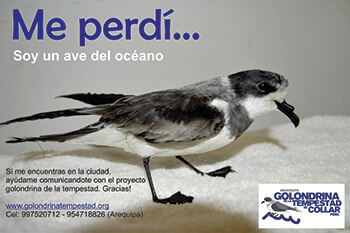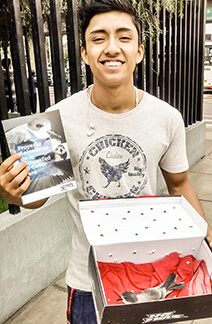Stranded Storm-Petrels Get a Second Chance in Lima
Every year, residents of Lima, Peru, find stranded seabirds on their city streets. The young Ringed Storm-Petrels are fledglings who've just left their nesting colonies for the first time and are embarking on their maiden journey out to sea. Like others of their kind, the birds are attracted to the bright lights of coastal cities. They become disoriented, collide with power lines or other structures, circle until they're exhausted, and finally drop to the ground.
That's where the Ringed Storm-Petrel Project comes in. Since 2013, the project, which receives financial support from several conservation organizations, including ABC, has rescued and rehabilitated nearly 500 grounded seabirds. More than 90 percent of the birds are returned to the wild after a few days of care.

Ringed Storm-Petrel in hand, PGTC
In helping the storm-petrels find their way, the project's leaders, Yovana Murillo and Betto Delgado, both veterinarians, are forging valuable connections with residents of the sprawling metropolis—home to nearly 10 million people—and educating those who find and rescue birds on how to reduce light pollution.
They are also collecting essential information about an elusive seabird scientists still know very little about. Dr. Murillo tells us more.
Libby Sander: How do you find the grounded seabirds?
Yovana Murillo: Local citizens find these seabirds all over the city. In the street, in their houses, on buildings, outside train stations. They pick up the birds because they think they are pigeons. But when they look at the birds' features closely, they see webbed feet and tube-shaped nostrils. They often find and contact us through our Facebook page, Golondrina de la Tempestad de Collar.
The citizens deliver the birds to Ricardo Palma University, where our rehabilitation facilities are located in the Veterinary Medicine School. We give people information about their rescued birds, such as their “pelagic” or open-ocean lifestyle, and we tell them about the problem of light pollution. We also explain our rescue efforts.
Finally, we take a picture of them and post it on our Facebook page. People like that. They share the post in their own social media networks and feel they have made a valuable contribution of time and effort to the conservation of these birds.

(Left: "I am lost…I am a seabird." The poster urges people who find downed seabirds to contact the Ringed Storm-Petrel Project. Photo: PGTC)
LS: When is the rescue season? Why are these months so dangerous for the birds?
YM: Every April to July—the time of year when these birds leave their nesting colonies—citizens of Lima find the Ringed Storm-Petrels. May is the month when the greatest number of fledgling birds are grounded. Once stranded on the ground, the birds cannot get the lift they need to fly off to sea.
LS: You've noticed there are some areas of metropolitan Lima where citizens repeatedly find grounded petrels every year. Why are so many birds found there?
YM: We have identified six such “hot spots.” We presume that light pollution is greater in these places than other parts of city, but it does not always seem to be the case. So we are working to understand what makes birds ground in the same area.
With ABC's support, we are beginning to characterize the buildings, light fixtures, and other structures the birds might collide with in those areas, such as power lines.
LS: What do you do with the birds once they are brought to you?
YM: The seabirds come to us exhausted, dehydrated, and dirty. In a short rehabilitation period, usually less than 24 hours, veterinarians at our facility evaluate the seabirds' physical condition.
We also collect biometric data and band every bird. We rehydrate and feed them, and make sure their feathers are waterproofed. Because birds can land in garbage, oil, or other substances on the ground, these substances can compromise their feathers' ability to keep the birds dry and warm when they go to sea.
If they don't stay waterproofed, they will soon become hypothermic and die. We can wash their feathers to make sure they are ready to go to sea.
LS: Do the birds survive?
YM: Every season we have the opportunity to rehabilitate and release more than 90 percent of the storm-petrels Lima residents rescue. Although the project has a high rehabilitation rate, sometimes we receive birds with traumas and lesions, or broken flight feathers. These birds don't survive because it is difficult to maintain seabirds in captivity for a long time. The longer they are in care, the greater the risk of catching a fungal infection in their lungs.
LS: What do you hope to accomplish in coming years with this project?

Wilson's Storm-Petrel, Luke Seitz
YM: First, we need to develop a detailed map showing all of the reports we have collected during the last three years of stranded petrels in the cities along the coast of Peru. This way, we can identify hot spots in Lima and other focal areas where repeated groundings occur. We can then take that information to the municipality and utility companies to help them initiate actions that would reduce light pollution.
We would also like to increase the reach of our rescue network to include other coastal cities, where reports of grounded Wilson's, Markham's, and Wedge-rumped Storm-Petrels have been recorded.
More broadly, we need more work with storm-petrel experts to create a plan for the species' conservation. Perhaps our work will ultimately help to inform expeditions to determine the Ringed Storm-Petrel's nesting areas and identify its flight corridors. Knowing this would help us take action to protect colonies from light pollution and other potential threats.

(Left: Miguel Angel Arce rescued this Ringed Storm-Petrel from the streets of Lima in July 2015. Photo: PGTC)
LS: Where do you release the storm-petrels, and how?
YM: After a short rehabilitation period, the storm petrels are ready for release into the wild. We release birds at night because that is the time when they are most active. We transport the birds to a spot at the southeastern edge of metropolitan Lima known as el salto del fraile, or “the jump of the priest.” It is a cliff above the Pacific Ocean and is located in the darkest place in the city.
We gently toss the rehabilitated birds into the wind, one at a time, and they open their wings and take flight—continuing their path to the open water.
Releasing one of these birds is the culmination of the work of many people: the volunteers who take care of the birds, the veterinarians who do the rehabilitation, and most importantly the people who rescue the birds.
All of them give these seabirds a second chance to return to the sea.
 Yovana Murillo is a licensed veterinarian and coordinator of the Ringed Storm-Petrel Project. In 2009 she started rescue efforts to help storm-petrels that were grounded in urban areas of the city of Lima. Dr. Murillo has been the project's lead since 2013 and is responsible for the veterinary assessment of the individual birds. Dr. Murillo has experience in developing guidelines for the enforcement of public policy for wildlife management, and has developed projects in the conservation and wildlife health program at the Wildlife Conservation Society in Peru.
Yovana Murillo is a licensed veterinarian and coordinator of the Ringed Storm-Petrel Project. In 2009 she started rescue efforts to help storm-petrels that were grounded in urban areas of the city of Lima. Dr. Murillo has been the project's lead since 2013 and is responsible for the veterinary assessment of the individual birds. Dr. Murillo has experience in developing guidelines for the enforcement of public policy for wildlife management, and has developed projects in the conservation and wildlife health program at the Wildlife Conservation Society in Peru.


















































